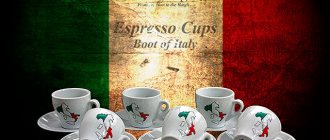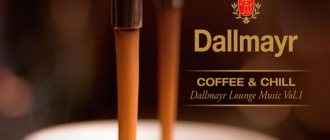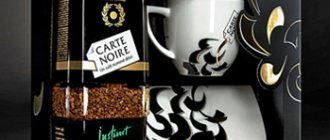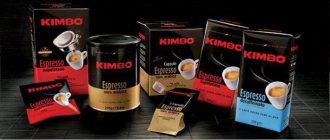Italians claim that their country is the cradle of coffee, and Italian coffee is the most delicious. In some respects this is certainly true. Although the plant is grown in other countries, Italy gave the world the tradition of preparing the drink. Italians are so proud of their coffee culture that even the world famous Starbucks only opened its first branch here in 2018, almost 30 years after the company was founded.
When coffee first appeared in Italy (in Venice in the 16th century), it created a sensation. It may seem funny today, but the priests of that time considered it a sinful drink coming from the devil himself. But it was a lucrative commodity, and soon became a luxury that only rich people could afford. With the development of colonialism, Europeans created their own coffee plantations, thanks to which the price of beans fell and they spread to all levels of society. It was Italy that gave the world the legendary bialette and created the espresso machine in the form that is known today.
Why is Italian coffee so delicious?
Kimbo
Kimbo is called the #2 brand for making the best espresso. Its history began after the founding of Cafè do Brasil, which produces this brand of coffee, in 1963. If you've heard that Neapolitan is the best coffee in Italy, then you should also know that Kimbo is a brand from Naples, the city with the most developed coffee culture in the country.
Dessert for coffee
Tiramisu is considered a traditional Italian dessert for coffee. And although today this delicious dessert is prepared all over the world, it was born in Italy. The associations that arise in your head when you hear the word tiramisu are soft cheese, airy cookies, dark chocolate and, of course, coffee...real, hot, thick, aromatic with a slight bitterness.
Soft Italian mascarpone cheese is used to prepare this culinary miracle. In appearance it looks like very thick cream, but in taste it resembles not at all sour cottage cheese. The second integral element of tiramisu is savoiardi biscuits, glazed with sugar crumbs.
Biscuit fingers are soaked in a mixture of strong black coffee and alcohol. The alcohol can be cognac, brandy or liqueur, such as coffee. The soaked cookies are layered with delicious cheese and sprinkled with grated dark chocolate on top. If the cake is to be served on a children's table, then strong drinks should be excluded from the recipe.
The only drawback of this wonderful dessert is its high calorie content. Therefore, those who are prone to excess weight should probably not get carried away with such tempting tiramisu. But you just need to try a small piece.
Mauro
The name of this coffee brand is associated with the name of Demetrio Mauro. In 1936, he came to Africa from his native province of Reggio Calabria, where he opened a travel agency. After the war, he developed a new passion - coffee, to which he devoted his entire life, founding the Mauro brand in 1949.
How to drink coffee the Italian way
There are several unwritten rules regarding coffee consumption that Italians try to adhere to in everyday life:
- Drink coffee drinks with added milk only before noon. Many people have heard about this “rule,” but not everyone knows what exactly it involves. In fact, reducing milk consumption in the afternoon is explained by the fact that in the evening hours it is poorly absorbed by the body and slows down metabolism. But a cup of strong coffee, on the contrary, helps stimulate it, so in Italy it is customary to drink espresso (caffè) after a meal in order to digest what you have eaten;
- In Italy, there is no fashion for prolonged drinking of coffee drinks, to which we are so accustomed. Here it looks more like: dropped into a bar, drank coffee, exchanged a few words with the barista and left;
- Drink coffee at the bar. This is done in order not to overpay for table service, which is automatically included in the bill if you decide to sit down and slowly drink coffee (+ 1-3 euros);
- While you are in Italy, forget about the popular “coffee-Americano”: according to the Italians, it’s just (we quote): “. poor and unfortunate caffè espresso, impossibly diluted with water to the point. incomprehensible slurry!
And one more thing: drinking cappuccino and any other coffee drinks during lunch or dinner (at the same time as the main courses) is considered truly wild, see the rules of conduct in an Italian restaurant
Pellini
Pellini coffee is a family affair: the brand was founded by the Pellini brothers in Verona in 1922. Today it is one of the best brands of Italian coffee thanks to its long history, during which the production process has been constantly improved, and the strictest control of technology. Pellini supplies coffee to top restaurants and hotels, and retails coffee beans, ground coffee and capsules all over the world.
What to order in an Italian cafe?
The above types of drink belong to Italy. But they are less common than the following types found on all cafeteria menus. Let's see what to order when relaxing in an Italian cafe.
• Piccolo. This name is more often used in eastern Europe. But it may also be present in Italy. The word "piccolo" indicates the size of the desired drink - 30 ml.
• Espresso (“Espresso”). This type, already mentioned several times, is characterized by an expressive taste, rich, thick coffee foam. It is prepared using a lever or automatic coffee machine, usually from 7g of quality freshly ground beans and 25-30ml of water. Cooking takes about 25 seconds.
• Doppio, double shot (“Doppio”, “Double shot”). This is a double portion (14 g) of coffee in 1 cup. Doppio, which is about 60 ml, is usually served in a 150 ml cappuccino cup. With such strong coffee, water is supplied at the same time as a matter of course.
• Ristretto (“Ristretto”). Very strong, intense coffee, which, unlike espresso, has a smaller volume of water - 20 ml. The preparation of these drinks is no different. The only difference is the speed of water supply. The coffee machine takes about 15-18 seconds to extract.
• Americano (“Americano”). This is espresso topped with hot water. Typically this ratio is 1:5. By diluting coffee in a 1:1 ratio, a coffee drink called lungo is prepared. Preparing such a large volume in a coffee machine requires too long an extraction time, which ruins the quality of the resulting drink.
• Cappuccino. Its total volume is 150-180 ml. It is based on classic espresso, warm milk and micro milk foam. Milk for making cappuccino must be whole milk, and its whipping temperature should not exceed 70°C. In recent years, it has become popular to add flavor to cappuccino using syrup (vanilla, chocolate, caramel).
• Flat White. Prepared similarly to cappuccino. The basis of this drink, in addition to warm milk and milk microfoam, is also a double dose of espresso, i.e. espresso doppio.
• Latte macchiato. Has a volume of about 250 ml. Milk plays an important role in this popular coffee drink. It is first foamed and classic espresso is slowly added to it. A properly prepared latte macchiato consists of three optically separated layers - coffee, milk and milk foam.
• Caffé latte. This is regular coffee with milk foam. It is served in large porcelain cups, without separated layers.
• Cafe Mocha (“Caffé mocha”). This is a latte option. It is a combination of espresso, chocolate and milk foam. The drink is prepared in a volume of 250 ml, recommended (and in many cafes also served directly) with whipped cream. When prepared correctly, it is difficult to guess where the taste of coffee ends and the taste of chocolate begins.
• Espresso macchiato. This is espresso prepared in an 80 ml cup; in the middle there is a small amount of milk microfoam. Macchiato can be decorated with latte art on the surface of the foam. Often, when ordering this coffee from Italy, tourists pronounce its name incorrectly. It's not "machato" or "machiato", but "macchiato".
5 minute video about Italian coffee
Caffè Vergnano 1882
Another oldest coffee company, founded in 1882 in Chieri, near Turin. By now, the brand has grown into more than just a major coffee producer. Throughout Italy, mainly in the North, there are Caffè Vergnano 1882 coffee shops; the brand offers a wide range of coffee, including capsules, coffee machines and even tea.
PARTNER ADVERTISING
Coffee recipes popular in Italy
There are many different recipes for preparing coffee drinks in Italy, it all depends on consumer preferences.
Italian coffee recipe with milk base
For preparation you will need: ground coffee 10-12 g and milk 400 g.
How to cook:
- coffee is poured into a special container and filled with milk;
- Next you need to put it on low heat and wait for it to boil;
- then remove from heat and leave covered for several minutes;
- Strain the coffee and pour it.
For a milk-based coffee drink, it is correct to offer sugar in a sugar bowl or sticks.
Italian coffee Fredo
To prepare this coffee you need: coffee, granulated sugar, dairy product, ice, and liqueur if desired.
How to cook:
- prepare regular espresso, pass it through a mesh, add granulated sugar and completely dissolve and remove until cool;
- add chilled cream and liqueur to the cooled coffee and mix;
- then beat all the ingredients with a mixer or food processor and pour into portions;
- You need to put a few ice cubes in each serving.
This coffee drink is served immediately.
Italian cappuccino
In order to prepare the drink, you will need: ground coffee - 0.25 l, pasteurized milk - 120 ml, a couple of grams of cinnamon, granulated sugar individually.
How to cook:
- First, brew regular espresso, adding sugar is allowed, filter it and pour it into cups;
- The milk must be whipped until fluffy foam is obtained. If you don’t have the necessary equipment for this, then you can beat it over a fire with a convenient device until it becomes fluffy and thick;
- regular coffee poured into a container should be covered with a thick layer of prepared foam and sprinkled with cinnamon.
Serving the drink with confectionery is recommended.
Coffee recipe with mint and grappa
You will need: ground coffee, grappa, crushed ice, sugar and mint leaves.
How to cook:
- Prepare the coffee initially, filter it and put it away until it cools;
- the next stage is mixing coffee with the prepared cold product, grappa and sugar, beat until foamy;
- Pour into glasses and add mint on top.
Amaretto
Ingredients: ground coffee, amaretto and sambuca liqueurs, whipped cream.
How to cook:
- brew regular coffee, filter;
- make a mix of liqueurs;
- pour brewed coffee into the liqueurs;
- Before serving, decorate with whipped cream.
To serve, you can use a regular wide cup or Irish glass.
Galliano coffee recipe
You will need: ground coffee 120 ml, whipped milk cream 120 ml, herbal liqueur 15-20 ml.
How to cook:
- brew coffee and pour into a cup;
- mix the cream with liqueur and beat thoroughly;
- Place whipped cream and liqueur on coffee.
All Italian coffees are individual with their own twist. Coffee Italy simply cannot fail to taste delicious. If you have the opportunity to visit Italy, you should definitely try this drink in different variations of preparation. No country can brew identical coffee.
Video. Perfetto! Secrets of Italian coffee with Leonid Parfenov
Whipped coffee with grappa and mint
Compound:
- black coffee – 120 g;
- grappa - 20 ml;
- crushed ice – 20 g;
- sugar – 5 g;
- mint – 1 leaf.
Cooking method:
- Brew coffee, strain if necessary, cool.
- Mix with sugar, grappa and crushed ice. Beat in a mixer until foam forms.
- Pour into a glass and garnish with a mint leaf.
The result is a very unusual refreshing cocktail, to which grappa gives a purely Italian touch.
Italian stamps
A large number of famous coffee brands are concentrated in the country. Therefore, tourists often ask whether coffee grows in Italy. Despite the fact that the country occupies a leading position in its production, the local climate is not suitable for cultivation.
Italian manufacturers have developed unique technologies for roasting coffee beans, which are rightfully considered the best in the world. They have perfectly mastered the blending technique, skillfully combining grains of different varieties, amazingly achieving a drink that is balanced in taste and aroma.
Let's look at the most famous coffee brands in Italy, and it's up to you to decide which one is better to buy.
Illy coffee
This is a family business, founded by Francesco Illi. In 1933, he opened a company that roasted beans. The following year, the company patented packaging for coffee using inert gas, which preserved the unique coffee aroma.
Today Illy is a leading Italian coffee brand. Arabica beans are supplied from Ethiopia, India, Brazil, and Colombia. Illy products are distinguished by floral and fruity notes in taste and a chocolate aroma that literally drives you crazy even when you open the package.
In Italian stores, Illy can cost around 5.3 € (Illy Moka Tostatura Media, 200 g can) or 7.20 € (Illy Espresso Tostatura Media, 250 g can).
Lavazza
One of the largest Italian coffee companies. Its founder is Luigi Lavazza. The company produces many different types of coffee, which differ in the different ratios of two main components: Arabica and Robusta. They produce both coffee beans and ground coffee.
All types differ in taste and aroma, from floral-spicy to chocolate taste with bitterness. Among the many Lavazzas, everyone will find a drink to their liking. And Italians often buy: Lavazza Qualità Rossa Grani (pack of 1000 g - 14.50-15 €) and Lavazza Crema e Gusto Classico (pack of 250 g - 3 €).
Pellini
An advanced plant in Verona for processing coffee beans, winner of many certificates and awards at the international level. Pellini coffee is an absolutely pure Italian product, without the use of impurities or flavorings.
Pellini Top 100% Arabica enjoys constant love among customers. It has a multi-faceted taste with notes of flowers, fruits, honey and chocolate. The cost of a 250 g can in Italian supermarkets is 5.78-6 €.
Kimbo
Starting from a small factory opened in the middle of the last century, Kimbo has become the second largest producer of packaged coffee. Various types of roasting of beans in the best Italian traditions and the skill of blending allow us to create drinks with a rich taste and deep aroma of different shades - from fruity citrus to wine notes.
When choosing what kind of coffee to bring from Italy, pay attention to ground Kimbo Espresso Napoletano, the cost of a 250 g package is about 4 €.
Molinari
The company began its activities by selling wine, spices and delicacies. At the beginning of the 20th century, they opened a coffee shop, after which they decided to focus specifically on the coffee business. Today the brand produces a huge line of natural Italian coffee - beans, ground, and in capsules.
One of the company's new blends, which is based on advanced developments in roasting coffee beans, is The Molinari Platino Roasted Coffee. An exquisite gourmet drink with low acidity, rich aroma and velvety consistency.











